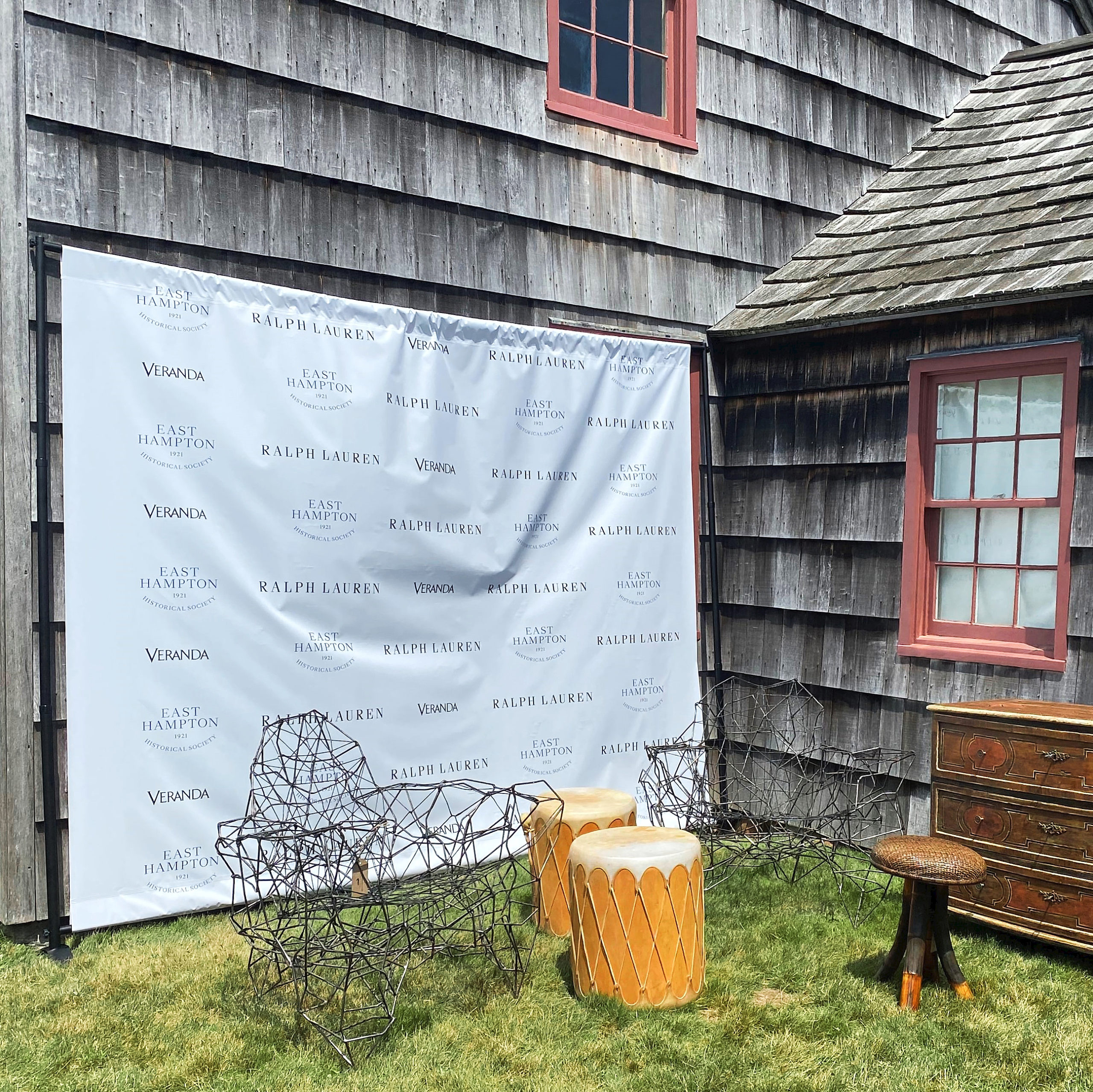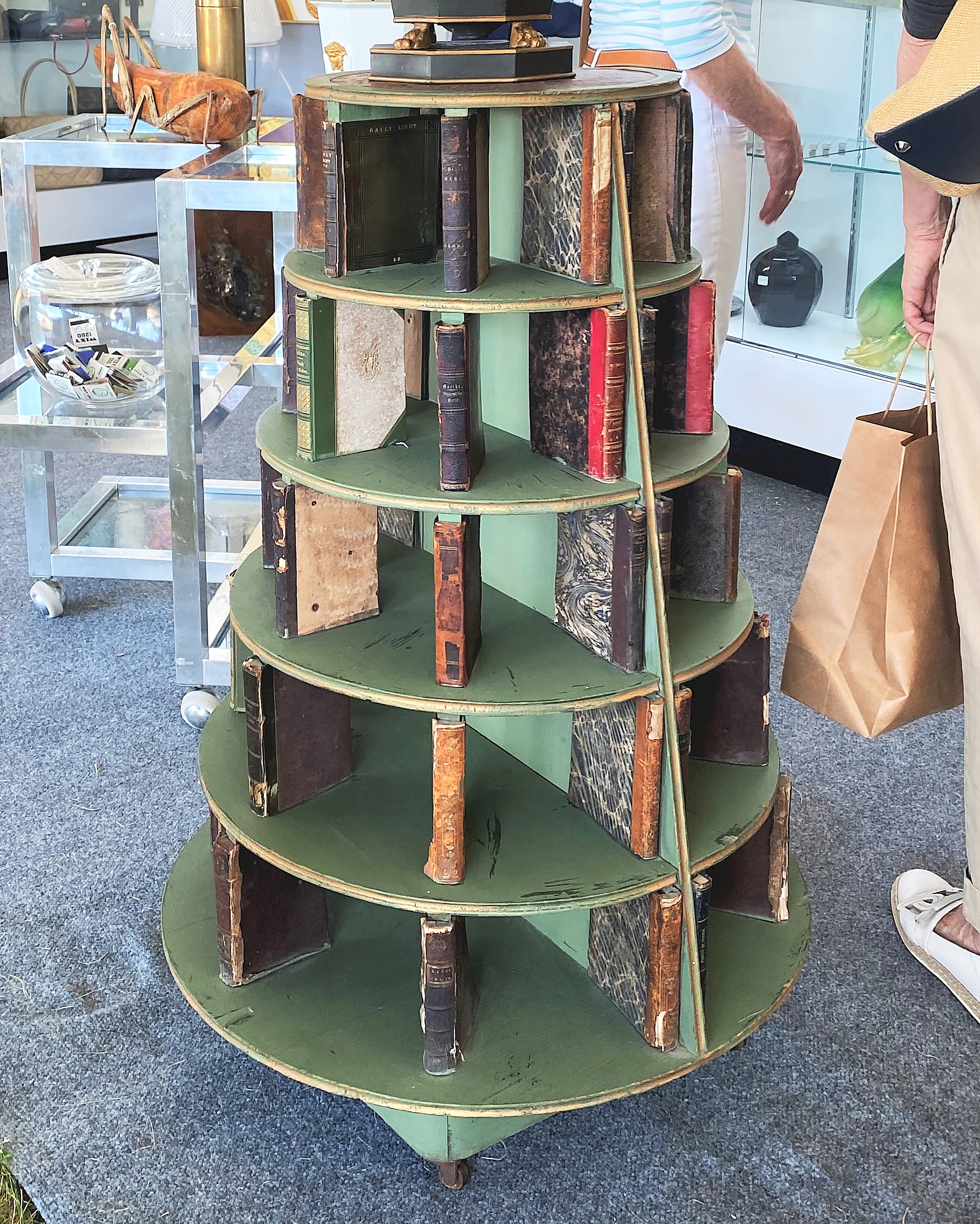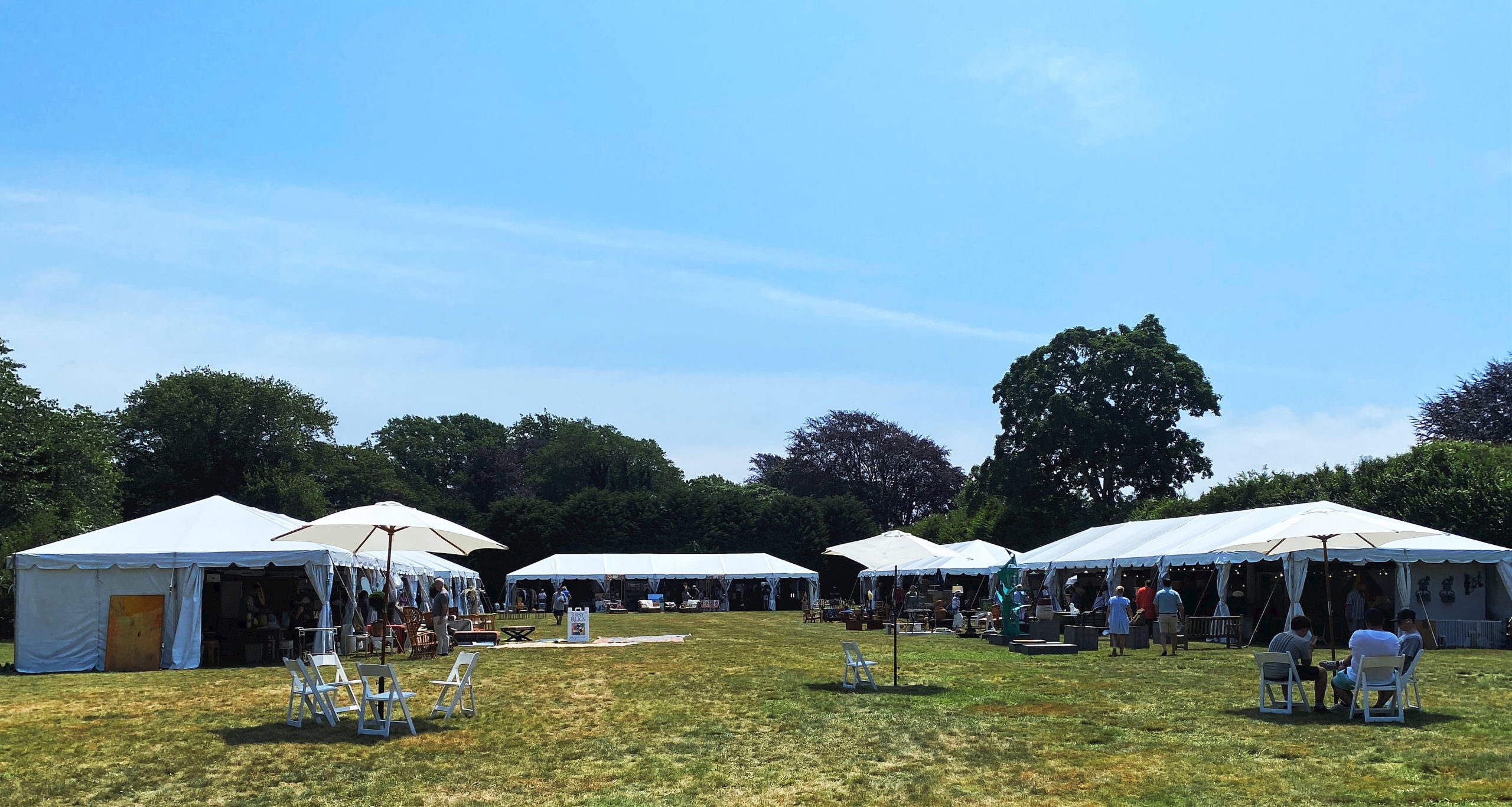
The clouds cleared just in time for the show’s preview cocktail event on July 14. Rossa Cole Photography.
Review & Photos by Z.G. Burnett
EAST HAMPTON, N.Y. — The East Hampton Antiques & Design Show celebrated its 17th anniversary this summer, beginning with its preview cocktail party on July 14 and continuing through July 16. Up until just hours before, rain bucketed down on the Mulford Farm Museum, part of the East Hampton Historic Society (EHHS). The organizing team held out on cancellation and were rewarded with a mild, sold-out evening for the preview with proceeds benefiting the EHHS. Guests included fashion designer and entrepreneur Liz Lange as honorary chairperson, Aerin Lauder, Laura Doyle, vice chairman and chief executive officer of Doyle Auctions and other benefactors. Sponsors included Ralph Lauren, also an EHHS benefactor, and Veranda magazine. An EHHS representative shared that tickets sold out early during the preview, and that the majority of guests left with antiques and art in hand.
Indeed, many sold tags were posted the next morning throughout the booths of more than 50 dealers. A number of dealers present had been showing at EHHS for years, while others were setting up for the first time. All reported lively sales the previous evening and were optimistic for the upcoming weekend. The celebrity guest sightings continued throughout the weekend, including Joy Behar with her dog Bernie in tow, model Christie Brinkley and Jill Rappaport. Through Saturday and Sunday, the show welcomed more than 1,500 shoppers.
Before the show’s opening, its dealers and supporters predicted trends that were likely to translate into sales over the course of the weekend. Ronald Wells of Wells & Company, Hudson, N.Y., noticed a return to maximalism in collectors’ buying. “It’s rich in colors, textures and collections of objects that are personal to the buyer. Just think of extreme minimalism and take it to the opposite direction,” Wells wrote. “But that does not mean that you are adhering to one particular time period. Instead, clients are looking at quality, rarity and personal appeal rather than what’s ‘hot.’ It is a true sign of autonomy of thought in design.”

Golden hour over Village Braider, Plymouth Mass., and Withington & Company, Cape Neddick, Maine, on July 14. Rossa Cole Photography.
Wells observed that, in addition to eclectic sensibilities taking hold, shoppers are less beholden to the viewpoints of hired help than in recent years. “I used to have customers saying, ‘I love it, but I have to check with my interior designer,’” he shared, with ideas about the cause for this new development. “During Covid, people had more time in their homes and more time to think about what they wanted to surround themselves with, when they just didn’t have that before.” Although there were still many interior designers in attendance, other dealers shared that there was a marked increase in private collectors that were buying at the show.
Exhibitors’ booths are always replete with inspiration at East Hampton, showcasing each vendors’ specific tastes down to the dividing walls’ paint. DGA – Objects of Art, Chagrin Falls, Ohio, created a gracious parlor in theirs that may have been extracted from a Palm Beach bungalow. One centerpiece of their stock was a rare ceramic Wiener Werkstätte bowl in the colorful form of a flamingo lineup that Diane, owner of DGA, said she had never seen before from the Viennese maker. A painting by Renée Demsey hung on the outer wall of their booth, mirroring the arrangement of table and chairs with a multi-patterned scene of a bedroom. Demsey was the in-house artist at Bergdorf Goodman in the 1970s, and this was one of a few paintings of hers that were spotted during the show from other exhibitors.

One of a few paintings by American artist Renée Demsey offered by different dealers at the show, this example was offered in a Palm Beach-themed arrangement by DGA – Objects of Art, Chagrin Falls, Ohio.
It was not all pastels and florals, however. Two new vendors posted side-by-side were showing a darker palette, but with no less exquisite offerings. Zoë Hoare of Hoare & Hoare Antiques, Bridgehampton, N.Y., put down her stakes and a concrete bulldog sculpture as her emblem for the first time and was already pleased with sales by Saturday morning. Hoare lives a stone’s throw from East Hampton but hails from Australia, where her mother was an antiques dealer while she was growing up. Visitors gravitated towards a large Eighteenth Century Italian cabinet in her booth, painted later in a striking harlequin pattern. Although the cupboard did not sell during the show, it is available on her website and online chairish.com shop. It was complemented by other European country furniture, a collection of Nineteenth Century American and European tools artfully arranged on her booth’s wall and other intriguingly unusual goods.
Hoare & Hoare’s neighbor was Newlyn Lowly Antiques, Hudson, N.Y., showcasing fine art, furniture and objects dating up to contemporary makers. Atop a Midcentury Modern table with six matching bentwood chairs was a mounted lion’s skull, which was remarkable in itself. However, owner Ryan W. Wagner pointed out a small plaque on its reverse, revealing that the mount was made by American explorer, sculptor and scientist James L. Clarke (American, 1883-1969). Hired by the American Museum of Natural History, Clark succeeded chief taxidermist Carl Akeley and created some of the museum’s most notable dioramas and taxidermy groups that are still on display today.

Colette Donovan Antiques, Merrimac, Mass., brought this rare Nineteenth Century New England rug, which was yarn-sewn instead of hooked, on a homespun linen foundation.
More traditional antiques were also in abundance. Colette Donovan of Merrimac, Mass., brought a broad selection of Americana, including a rare yarn-sewn wool rug on linen. Unlike their hooked counterparts, sewn rugs were more akin to samplers in that they were meant to display the maker’s skill and refinement, rather than to be used as floor coverings. Their materials were also usually higher quality and featured more intricate, time-consuming designs. Donovan determined that this Nineteenth Century example was from New England, and it attracted much attention on the outer wall of her booth.
Tom Luciano, Phoenicia, N.Y., brought handmade contemporary works, Eighteenth Century European French furniture and Asian art together in his booth. One tabletop was full of accessibly priced, hand-thrown ceramics, some of which were Luciano’s own design. Other notable makers included Karen Karnes (1925-2016) and Walter Addison (1914-1982). Karnes was a lifelong maker best known for her salt-glazed ceramics and stoneware in earthy, natural tones, and was the subject of both a documentary and a book on her work. Addison was a Guggenheim fellow, among other awards, who worked as the Bronx Zoo’s lead artist in the 1940s, creating murals for the zoo’s enclosures and later receiving many private and public commissions for animal sculptures. His plates and dishes on display on Luciano’s table showed deer, ibex and butterflies, and Karnes’ work were excellent examples of her oeuvre.

This large Minton Majolica jardiniere was prominently displayed by the Ann Parke Collection, Darien, Conn.
Earlier ceramics were available in Sheryl Dunleavy’s booth, who was showing as the Ann Parke Collection, Darien, Conn., for the second year. Front and center was a large Minton majolica jardiniere from the Nineteenth Century with a striking, sky-blue fluted body and powerful polychrome ram’s head handles. The body and base were decorated with swags, fruit and pink-painted ribbons. Dunleavy shared that a similar piece to this was shown at the Great Exhibition of 1851 modeled by Baron Carlo Marochetti (1805-1867), who was born in Turin but lived and worked in England as his work was favored by Queen Victoria and Prince Albert. His monumental plaster sculpture of “Richard the Lionheart” stood outside of the Great Exhibition before being cast in bronze and installed outside the House of Lords, where it remains today.
Whereas many dealers specialized in the decorative, others stocked objects that were beautifully crafted but still meant to be used. Piggy Kitchen, Chicago, is one such dealer that has consistently shown at Easthampton through the years, overseen by founders Bill Borman and Richard Thomas. “We handpick every piece,” Borman explained. “You just can’t beat the quality of these older pieces.” Borman and Thomas have been traveling through France for the past 20 years sourcing their stock, learning not only about the history of the country’s gleaming copper cookware but also how to use and live with it. When asked about the shop’s distinctive name, Borman explained that it was about the maximalism that comes with a well-stocked and well-equipped kitchen. He shared his reaction to such a kitchen they encountered in France, that was so unapologetically lush that there was no other word for it except “piggy!” With the number of customers drawn by the shiny collection and kept by their craftsmanship, Borman and Thomas are far from alone in their appreciation.

Mayan incensario, circa 900-1100 CE, from Mark Shilen Antique Indian Dhurrie Rugs, East Hampton, N.Y.
One of the earliest objects at the show was found in one of the most unexpected booths, an example both of the exhibitors’ breadth of concentrations and knowledge. Mark Shilen Antique Indian Dhurrie Rugs, East Hampton, N.Y., presented many such carpets in his prominent double booth but also an example of his other passion, pre-Colombian artifacts. Sharing the front table with him was a mounted Mayan incensario from the late classic period (900-1100 CE). Although now a fragment and presented for its artistic merits, Shilen demonstrated how incense would be burned on the top of this ritual object’s head. He explained that though he has a small collection in this category, he mostly collects Peruvian textiles.
The East Hampton Historical Society’s Mulford Farm Museum is at 10 James Lane. For information, www.easthampton.org or 631-324-6869.






























